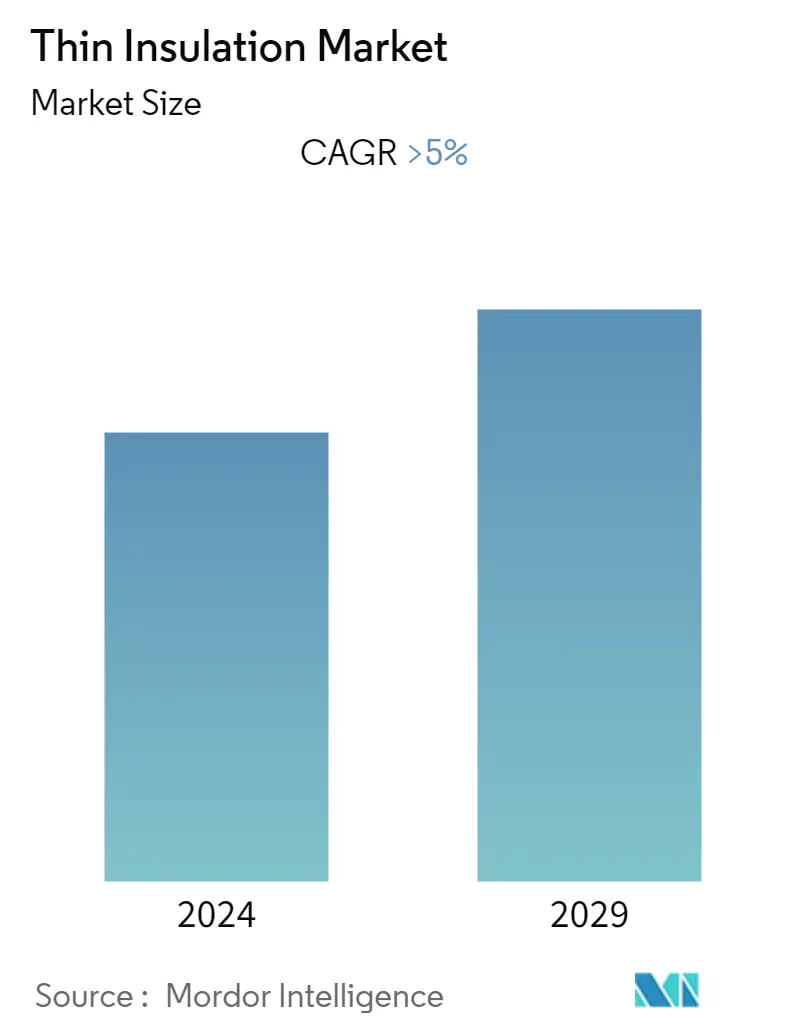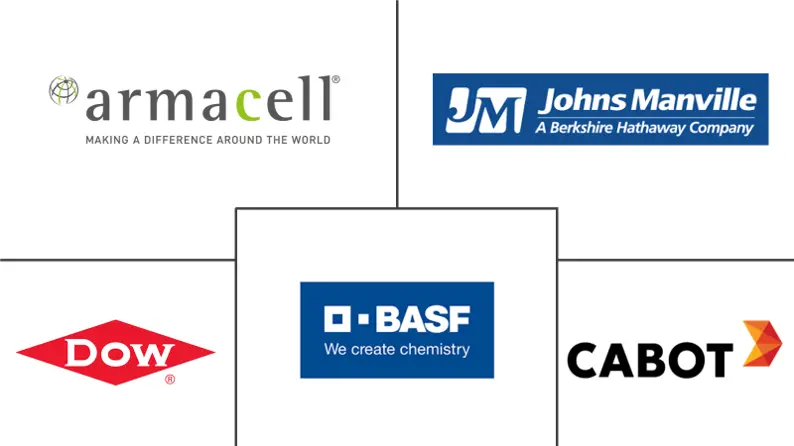Market Size of Thin Insulation Industry

| Study Period | 2019 - 2029 |
| Base Year For Estimation | 2023 |
| CAGR | 5.00 % |
| Fastest Growing Market | Asia Pacific |
| Largest Market | Asia Pacific |
| Market Concentration | Medium |
Major Players
*Disclaimer: Major Players sorted in no particular order |
Thin Insulation Market Analysis
The market for thin insulation is expected to register a CAGR of over 5% during the forecast timeframe. The major factor driving the growth of the market is the growing consumption in the building and construction sector due to better R-value or thermal insulation. Other factors, such as increasing utilization for insulation in high energy-consuming industries, like oil and gas, are expected to propel the interest of the market. On the other side, unfavorable conditions arising due to the COVID-19 outbreak are hindering the growth of the market.
- The building and construction segments make broad use of thin insulation, as these insulating materials take less space and cater to better thermal insulation compared to traditional insulating methods, thus, gaining an advantage over traditional methods.
- Asia-Pacific is forecasted to own the largest market share, due to the increasing building and construction activities and the upcoming projects in the region.
Thin Insulation Industry Segmentation
The thin insulation market report includes:
| Type | |
| Coatings | |
| Sheets and Films | |
| Foams | |
| Vacuum Insulation Panels | |
| Other Types |
| Materials | |
| Aerogels | |
| Metals | |
| Plastic Foams | |
| Other Materials |
| End User | |
| Automotive | |
| Aerospace | |
| Building and Construction | |
| Oil and Gas | |
| Other End Users |
| Geography | ||||||||
| ||||||||
| ||||||||
| ||||||||
| ||||||||
|
Thin Insulation Market Size Summary
The thin insulation market is poised for significant growth, driven primarily by its increasing application in the building and construction sector. This growth is attributed to the superior thermal insulation properties and space-saving advantages of thin insulation materials compared to traditional methods. The demand is further bolstered by the rising use of these materials in energy-intensive industries such as oil and gas. However, the market's expansion faces challenges due to the lingering impacts of the COVID-19 pandemic. The Asia-Pacific region is anticipated to dominate the market, fueled by robust construction activities and numerous upcoming projects, particularly in countries like China and India.
The construction industry's rapid expansion and urbanization are key factors propelling the demand for thin insulation materials. The sector's substantial global expenditure and the anticipated growth in various construction segments underscore the market's potential. Government initiatives and support further enhance the market's prospects. The Asia-Pacific region, accounting for a significant portion of the global market share, is particularly attractive for thin insulation due to its burgeoning construction sector. The market is characterized by partial consolidation, with major players like Dow, BASF SE, Cabot Corporation, Armacell, and Johns Manville actively participating in the industry.
Thin Insulation Market Size - Table of Contents
-
1. MARKET DYNAMICS
-
1.1 Drivers
-
1.1.1 Building and Construction Sector to Boost the Market Growth
-
1.1.2 Oil and Gas Industry to Propel the Product Demand
-
-
1.2 Restraints
-
1.2.1 COVID-19 Outbreak Hampering the Market Growth
-
1.2.2 Other Restraints
-
-
1.3 Industry Value-Chain Analysis
-
1.4 Porter's Five Forces Analysis
-
1.4.1 Bargaining Power of Suppliers
-
1.4.2 Bargaining Power of Consumers
-
1.4.3 Threat of New Entrants
-
1.4.4 Threat of Substitute Products and Services
-
1.4.5 Degree of Competition
-
-
-
2. MARKET SEGMENTATION
-
2.1 Type
-
2.1.1 Coatings
-
2.1.2 Sheets and Films
-
2.1.3 Foams
-
2.1.4 Vacuum Insulation Panels
-
2.1.5 Other Types
-
-
2.2 Materials
-
2.2.1 Aerogels
-
2.2.2 Metals
-
2.2.3 Plastic Foams
-
2.2.4 Other Materials
-
-
2.3 End User
-
2.3.1 Automotive
-
2.3.2 Aerospace
-
2.3.3 Building and Construction
-
2.3.4 Oil and Gas
-
2.3.5 Other End Users
-
-
2.4 Geography
-
2.4.1 Asia-Pacific
-
2.4.1.1 China
-
2.4.1.2 India
-
2.4.1.3 Japan
-
2.4.1.4 South Korea
-
2.4.1.5 Rest of Asia-Pacific
-
-
2.4.2 North America
-
2.4.2.1 United States
-
2.4.2.2 Canada
-
2.4.2.3 Mexico
-
-
2.4.3 Europe
-
2.4.3.1 Germany
-
2.4.3.2 United Kingdom
-
2.4.3.3 Italy
-
2.4.3.4 France
-
2.4.3.5 Spain
-
2.4.3.6 Rest of Europe
-
-
2.4.4 South America
-
2.4.4.1 Brazil
-
2.4.4.2 Argentina
-
2.4.4.3 Rest of South America
-
-
2.4.5 Middle-East and Africa
-
2.4.5.1 United Arab Emirates
-
2.4.5.2 Saudi Arabia
-
2.4.5.3 South Africa
-
2.4.5.4 Rest of Middle-East and Africa
-
-
-
Thin Insulation Market Size FAQs
What is the current Thin Insulation Market size?
The Thin Insulation Market is projected to register a CAGR of greater than 5% during the forecast period (2024-2029)
Who are the key players in Thin Insulation Market?
Dow, BASF SE, Cabot Corporation, Armacell and Johns Manville are the major companies operating in the Thin Insulation Market.

